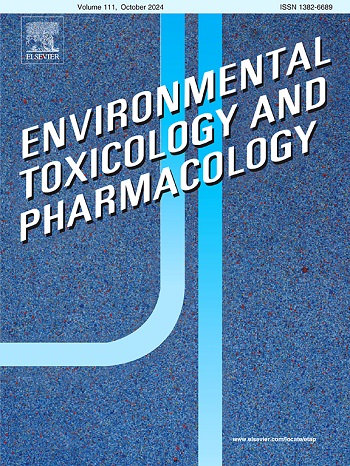全氟烷基和多氟烷基物质的生殖毒性。
IF 4.2
3区 环境科学与生态学
Q2 ENVIRONMENTAL SCIENCES
引用次数: 0
摘要
全氟和多氟烷基物质(PFAS)是合成的含氟化合物,以其在环境中的持久性和在消费品中的广泛存在而闻名。人体接触通过多种途径发生,导致在各种组织中的生物积累和重大的健康问题,特别是生殖毒性。这篇综述严格审查了长链和短链PFAS的生殖影响,并探讨了其毒性的机制。PFAS已被证明下调参与甾体生成的关键基因,包括甾体生成急性调节蛋白(StAR)、细胞色素P450酶(CYP11A1、CYP17A1)、3β-羟基类固醇脱氢酶和17β-羟基类固醇脱氢酶。此外,PFAS对发育中的精原细胞和卵母细胞产生直接毒性作用,损害生殖功能。虽然大多数研究都集中在长链PFAS上,但本综述强调短链PFAS具有相当的风险,需要进一步研究。生物降解PFAS的能力已经得到证实,这为减轻组织积累和降低相关健康风险提供了一种潜在的方法。然而,我们对PFAS机制的理解仍然存在差距,不同化合物和研究模型的证据相互矛盾。标准化方法和长期人体研究对于充分阐明全氟化砷接触的慢性影响和制定有效的缓解战略至关重要。本文章由计算机程序翻译,如有差异,请以英文原文为准。
Reproductive toxicity of per- and polyfluoroalkyl substances
Per- and polyfluoroalkyl substances (PFAS) are synthetic fluorinated compounds known for their persistence in the environment and widespread presence in consumer products. Human exposure occurs through multiple routes, leading to bioaccumulation in various tissues and significant health concerns, particularly reproductive toxicity.
This review critically examines the reproductive effects of both long- and short-chain PFAS and explores the mechanisms underlying their toxicity. PFAS have been shown to downregulate key genes involved in steroidogenesis, including steroidogenic acute regulatory protein (StAR), cytochrome P450 enzymes (CYP11A1, CYP17A1), 3β-hydroxysteroid dehydrogenase, and 17β-hydroxysteroid dehydrogenase. Additionally, PFAS exert direct toxic effects on developing spermatogonia and oocytes, impairing reproductive function. While most research has focused on long-chain PFAS, this review highlights that short-chain PFAS pose comparable risks, necessitating further investigation.
The ability to biodegrade PFAS has been demonstrated, offering a potential approach to mitigate tissue accumulation and reduce associated health risks.
However, gaps remain in our understanding of PFAS mechanisms, with conflicting evidence across different compounds and study models. Standardized methodologies and long-term human studies are essential to fully elucidate the chronic effects of PFAS exposure and develop effective mitigation strategies.
求助全文
通过发布文献求助,成功后即可免费获取论文全文。
去求助
来源期刊
CiteScore
7.00
自引率
4.70%
发文量
185
审稿时长
34 days
期刊介绍:
Environmental Toxicology and Pharmacology publishes the results of studies concerning toxic and pharmacological effects of (human and veterinary) drugs and of environmental contaminants in animals and man.
Areas of special interest are: molecular mechanisms of toxicity, biotransformation and toxicokinetics (including toxicokinetic modelling), molecular, biochemical and physiological mechanisms explaining differences in sensitivity between species and individuals, the characterisation of pathophysiological models and mechanisms involved in the development of effects and the identification of biological markers that can be used to study exposure and effects in man and animals.
In addition to full length papers, short communications, full-length reviews and mini-reviews, Environmental Toxicology and Pharmacology will publish in depth assessments of special problem areas. The latter publications may exceed the length of a full length paper three to fourfold. A basic requirement is that the assessments are made under the auspices of international groups of leading experts in the fields concerned. The information examined may either consist of data that were already published, or of new data that were obtained within the framework of collaborative research programmes. Provision is also made for the acceptance of minireviews on (classes of) compounds, toxicities or mechanisms, debating recent advances in rapidly developing fields that fall within the scope of the journal.

 求助内容:
求助内容: 应助结果提醒方式:
应助结果提醒方式:


